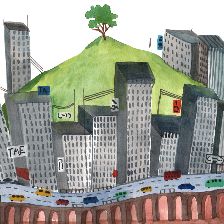
5 tips to reduce your ecological footprint
How you can help conserve valuable natural resources
Earth Overshoot Day is when humanity’s natural resource consumption exceeds what nature can regenerate that year. This day is getting earlier every year, and a sure sign that we humans need to change our consumption habits. Earth Overshoot Day is calculated by the non-profit organisation Global Footprint Network.
Reduce your ecological footprint – 5 simple ideas
Each one of us can play an active role in protecting the planet by reducing our ecological footprint. We don’t need to radically change how we live all of a sudden. Step by step, you can gradually make your daily life and habits more environmentally friendly.
Here are 5 simple tips to get started.
#1 Eat less meat and more plant-based food
One of the most effective ways to reduce your carbon footprint is to eat more plant-based foods. This is because animal products have a much bigger ecological footprint than plant-based products. Meat production consumes considerably more water and land and causes higher greenhouse gas emissions. Eating seasonal, regionally produced food helps to reduce global transport costs. And by shopping for fresh produce at your local farmers market, you avoid packaging waste.
#2 Fly less and travel instead by train, public transport, or bicycle
Mobility has a major impact on our personal ecological footprint. Air travel accounts for a considerable amount of CO2 emissions, meaning that every flight we don’t take is a gift for the environment. It’s more environmentally friendly to travel by train, bike or carpool. How you get around within your town or city makes a difference, too. Using public transport, cycling or walking are all environmentally sustainable ways to protect the planet.
#3 Buy less and only what truly makes you happy
Reduce, repair, reuse, recycle. Whether it’s clothing, furniture or electrical appliances, consuming less and more consciously saves resources. Before you buy something new, consider whether you really need it. Items that have reached their end-of-life should be recycled whenever possible. Tools or equipment that you rarely need can often be easily borrowed. Second-hand products that are already in circulation are always the more resource-efficient option. A rule of thumb: the longer products are used, the better their eco-balance. Opt for products that have been produced sustainably and according to fair trade practices, and which don't need to be transported over long distances.
#4 Save energy at home
During the heating period, you can save energy at home by turning down the temperature. How much we heat our homes has a considerable effect on our energy balance. Lowering the thermostat by just one degree reduces heating costs by about 6%. Other energy-saving habits include shutting down electrical appliances completely rather than leaving them on standby. Using an electric kettle is more efficient than boiling water on the stovetop. Install energy-efficient LED lightbulbs, and don’t forget to turn off the lights when you leave the room.
#5 Use renewable energy
A single, eco-friendly change with a powerful effect: switching to a genuine green electricity provider. Using clean, renewable energy can save an average three-person household around 2 tonnes of CO2 per year.
What is an ecological footprint?
Our ecological footprint, also known as our environmental footprint, represents the area on earth that we occupy with our way of life. With almost everything we do, we consume natural resources. A personal ecological footprint describes how much land is needed to support the resource consumption of one person. The ecological footprint is different from the carbon footprint, in that it includes other environmental impacts in addition to greenhouse gas (GHG) emissions.
How is the ecological footprint calculated?
The ecological footprint is measured in units of global hectares, or gha for short. The calculation looks at various factors: for example, clothing and food production, waste disposal, energy consumption, and carbon dioxide emissions. The result can then be compared with the biological capacity of the world or a region. Also known as biocapacity, this refers to the ability of an area to regenerate what people consume and to absorb their waste. If a country’s ecological footprint is greater than its biocapacity, more natural resources are consumed than the country can regenerate on its own. On a global scale, this is often depicted by the number of earths consumed by humanity.













